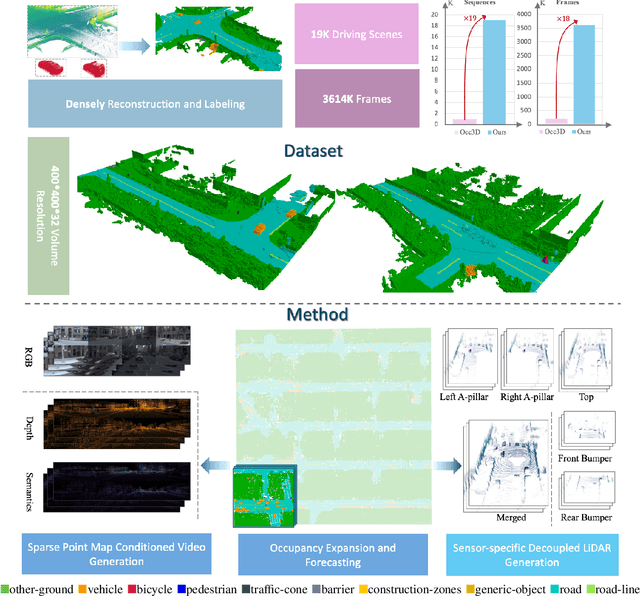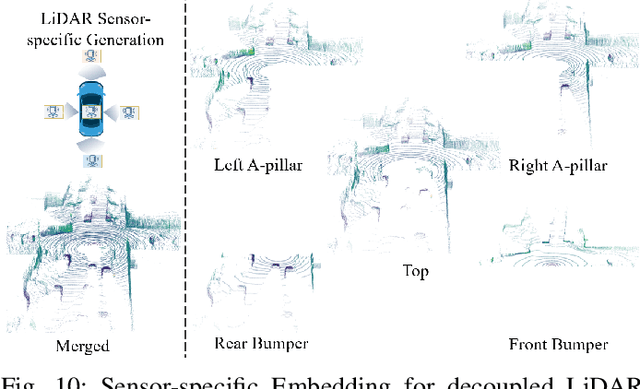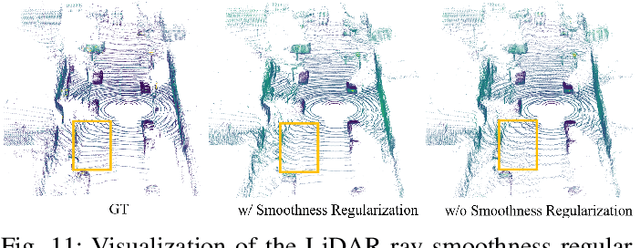Chao Ma
Patch-Discontinuity Mining for Generalized Deepfake Detection
Dec 26, 2025Abstract:The rapid advancement of generative artificial intelligence has enabled the creation of highly realistic fake facial images, posing serious threats to personal privacy and the integrity of online information. Existing deepfake detection methods often rely on handcrafted forensic cues and complex architectures, achieving strong performance in intra-domain settings but suffering significant degradation when confronted with unseen forgery patterns. In this paper, we propose GenDF, a simple yet effective framework that transfers a powerful large-scale vision model to the deepfake detection task with a compact and neat network design. GenDF incorporates deepfake-specific representation learning to capture discriminative patterns between real and fake facial images, feature space redistribution to mitigate distribution mismatch, and a classification-invariant feature augmentation strategy to enhance generalization without introducing additional trainable parameters. Extensive experiments demonstrate that GenDF achieves state-of-the-art generalization performance in cross-domain and cross-manipulation settings while requiring only 0.28M trainable parameters, validating the effectiveness and efficiency of the proposed framework.
LiteFusion: Taming 3D Object Detectors from Vision-Based to Multi-Modal with Minimal Adaptation
Dec 23, 2025Abstract:3D object detection is fundamental for safe and robust intelligent transportation systems. Current multi-modal 3D object detectors often rely on complex architectures and training strategies to achieve higher detection accuracy. However, these methods heavily rely on the LiDAR sensor so that they suffer from large performance drops when LiDAR is absent, which compromises the robustness and safety of autonomous systems in practical scenarios. Moreover, existing multi-modal detectors face difficulties in deployment on diverse hardware platforms, such as NPUs and FPGAs, due to their reliance on 3D sparse convolution operators, which are primarily optimized for NVIDIA GPUs. To address these challenges, we reconsider the role of LiDAR in the camera-LiDAR fusion paradigm and introduce a novel multi-modal 3D detector, LiteFusion. Instead of treating LiDAR point clouds as an independent modality with a separate feature extraction backbone, LiteFusion utilizes LiDAR data as a complementary source of geometric information to enhance camera-based detection. This straightforward approach completely eliminates the reliance on a 3D backbone, making the method highly deployment-friendly. Specifically, LiteFusion integrates complementary features from LiDAR points into image features within a quaternion space, where the orthogonal constraints are well-preserved during network training. This helps model domain-specific relations across modalities, yielding a compact cross-modal embedding. Experiments on the nuScenes dataset show that LiteFusion improves the baseline vision-based detector by +20.4% mAP and +19.7% NDS with a minimal increase in parameters (1.1%) without using dedicated LiDAR encoders. Notably, even in the absence of LiDAR input, LiteFusion maintains strong results , highlighting its favorable robustness and effectiveness across diverse fusion paradigms and deployment scenarios.
Grounding Everything in Tokens for Multimodal Large Language Models
Dec 11, 2025Abstract:Multimodal large language models (MLLMs) have made significant advancements in vision understanding and reasoning. However, the autoregressive Transformer architecture used by MLLMs requries tokenization on input images, which limits their ability to accurately ground objects within the 2D image space. This raises an important question: how can sequential language tokens be improved to better ground objects in 2D spatial space for MLLMs? To address this, we present a spatial representation method for grounding objects, namely GETok, that integrates a specialized vocabulary of learnable tokens into MLLMs. GETok first uses grid tokens to partition the image plane into structured spatial anchors, and then exploits offset tokens to enable precise and iterative refinement of localization predictions. By embedding spatial relationships directly into tokens, GETok significantly advances MLLMs in native 2D space reasoning without modifying the autoregressive architecture. Extensive experiments demonstrate that GETok achieves superior performance over the state-of-the-art methods across various referring tasks in both supervised fine-tuning and reinforcement learning settings.
Thermally Activated Dual-Modal Adversarial Clothing against AI Surveillance Systems
Nov 17, 2025Abstract:Adversarial patches have emerged as a popular privacy-preserving approach for resisting AI-driven surveillance systems. However, their conspicuous appearance makes them difficult to deploy in real-world scenarios. In this paper, we propose a thermally activated adversarial wearable designed to ensure adaptability and effectiveness in complex real-world environments. The system integrates thermochromic dyes with flexible heating units to induce visually dynamic adversarial patterns on clothing surfaces. In its default state, the clothing appears as an ordinary black T-shirt. Upon heating via an embedded thermal unit, hidden adversarial patterns on the fabric are activated, allowing the wearer to effectively evade detection across both visible and infrared modalities. Physical experiments demonstrate that the adversarial wearable achieves rapid texture activation within 50 seconds and maintains an adversarial success rate above 80\% across diverse real-world surveillance environments. This work demonstrates a new pathway toward physically grounded, user-controllable anti-AI systems, highlighting the growing importance of proactive adversarial techniques for privacy protection in the age of ubiquitous AI surveillance.
Scaling Up Occupancy-centric Driving Scene Generation: Dataset and Method
Oct 27, 2025



Abstract:Driving scene generation is a critical domain for autonomous driving, enabling downstream applications, including perception and planning evaluation. Occupancy-centric methods have recently achieved state-of-the-art results by offering consistent conditioning across frames and modalities; however, their performance heavily depends on annotated occupancy data, which still remains scarce. To overcome this limitation, we curate Nuplan-Occ, the largest semantic occupancy dataset to date, constructed from the widely used Nuplan benchmark. Its scale and diversity facilitate not only large-scale generative modeling but also autonomous driving downstream applications. Based on this dataset, we develop a unified framework that jointly synthesizes high-quality semantic occupancy, multi-view videos, and LiDAR point clouds. Our approach incorporates a spatio-temporal disentangled architecture to support high-fidelity spatial expansion and temporal forecasting of 4D dynamic occupancy. To bridge modal gaps, we further propose two novel techniques: a Gaussian splatting-based sparse point map rendering strategy that enhances multi-view video generation, and a sensor-aware embedding strategy that explicitly models LiDAR sensor properties for realistic multi-LiDAR simulation. Extensive experiments demonstrate that our method achieves superior generation fidelity and scalability compared to existing approaches, and validates its practical value in downstream tasks. Repo: https://github.com/Arlo0o/UniScene-Unified-Occupancy-centric-Driving-Scene-Generation/tree/v2
BachVid: Training-Free Video Generation with Consistent Background and Character
Oct 24, 2025Abstract:Diffusion Transformers (DiTs) have recently driven significant progress in text-to-video (T2V) generation. However, generating multiple videos with consistent characters and backgrounds remains a significant challenge. Existing methods typically rely on reference images or extensive training, and often only address character consistency, leaving background consistency to image-to-video models. We introduce BachVid, the first training-free method that achieves consistent video generation without needing any reference images. Our approach is based on a systematic analysis of DiT's attention mechanism and intermediate features, revealing its ability to extract foreground masks and identify matching points during the denoising process. Our method leverages this finding by first generating an identity video and caching the intermediate variables, and then inject these cached variables into corresponding positions in newly generated videos, ensuring both foreground and background consistency across multiple videos. Experimental results demonstrate that BachVid achieves robust consistency in generated videos without requiring additional training, offering a novel and efficient solution for consistent video generation without relying on reference images or additional training.
AnchorSync: Global Consistency Optimization for Long Video Editing
Aug 20, 2025Abstract:Editing long videos remains a challenging task due to the need for maintaining both global consistency and temporal coherence across thousands of frames. Existing methods often suffer from structural drift or temporal artifacts, particularly in minute-long sequences. We introduce AnchorSync, a novel diffusion-based framework that enables high-quality, long-term video editing by decoupling the task into sparse anchor frame editing and smooth intermediate frame interpolation. Our approach enforces structural consistency through a progressive denoising process and preserves temporal dynamics via multimodal guidance. Extensive experiments show that AnchorSync produces coherent, high-fidelity edits, surpassing prior methods in visual quality and temporal stability.
Cross-Architecture Distillation Made Simple with Redundancy Suppression
Jul 29, 2025Abstract:We describe a simple method for cross-architecture knowledge distillation, where the knowledge transfer is cast into a redundant information suppression formulation. Existing methods introduce sophisticated modules, architecture-tailored designs, and excessive parameters, which impair their efficiency and applicability. We propose to extract the architecture-agnostic knowledge in heterogeneous representations by reducing the redundant architecture-exclusive information. To this end, we present a simple redundancy suppression distillation (RSD) loss, which comprises cross-architecture invariance maximisation and feature decorrelation objectives. To prevent the student from entirely losing its architecture-specific capabilities, we further design a lightweight module that decouples the RSD objective from the student's internal representations. Our method is devoid of the architecture-specific designs and complex operations in the pioneering method of OFA. It outperforms OFA on CIFAR-100 and ImageNet-1k benchmarks with only a fraction of their parameter overhead, which highlights its potential as a simple and strong baseline to the cross-architecture distillation community.
Corvid: Improving Multimodal Large Language Models Towards Chain-of-Thought Reasoning
Jul 10, 2025Abstract:Recent advancements in multimodal large language models (MLLMs) have demonstrated exceptional performance in multimodal perception and understanding. However, leading open-source MLLMs exhibit significant limitations in complex and structured reasoning, particularly in tasks requiring deep reasoning for decision-making and problem-solving. In this work, we present Corvid, an MLLM with enhanced chain-of-thought (CoT) reasoning capabilities. Architecturally, Corvid incorporates a hybrid vision encoder for informative visual representation and a meticulously designed connector (GateMixer) to facilitate cross-modal alignment. To enhance Corvid's CoT reasoning capabilities, we introduce MCoT-Instruct-287K, a high-quality multimodal CoT instruction-following dataset, refined and standardized from diverse public reasoning sources. Leveraging this dataset, we fine-tune Corvid with a two-stage CoT-formatted training approach to progressively enhance its step-by-step reasoning abilities. Furthermore, we propose an effective inference-time scaling strategy that enables Corvid to mitigate over-reasoning and under-reasoning through self-verification. Extensive experiments demonstrate that Corvid outperforms existing o1-like MLLMs and state-of-the-art MLLMs with similar parameter scales, with notable strengths in mathematical reasoning and science problem-solving. Project page: https://mm-vl.github.io/corvid.
Co-Reinforcement Learning for Unified Multimodal Understanding and Generation
May 23, 2025Abstract:This paper presents a pioneering exploration of reinforcement learning (RL) via group relative policy optimization for unified multimodal large language models (ULMs), aimed at simultaneously reinforcing generation and understanding capabilities. Through systematic pilot studies, we uncover the significant potential of ULMs to enable the synergistic co-evolution of dual capabilities within a shared policy optimization framework. Building on this insight, we introduce \textbf{CoRL}, a co-reinforcement learning framework comprising a unified RL stage for joint optimization and a refined RL stage for task-specific enhancement. With the proposed CoRL, our resulting model, \textbf{ULM-R1}, achieves average improvements of \textbf{7%} on three text-to-image generation datasets and \textbf{23%} on nine multimodal understanding benchmarks. These results demonstrate the effectiveness of CoRL and highlight the substantial benefit of reinforcement learning in facilitating cross-task synergy and optimization for ULMs.
 Add to Chrome
Add to Chrome Add to Firefox
Add to Firefox Add to Edge
Add to Edge